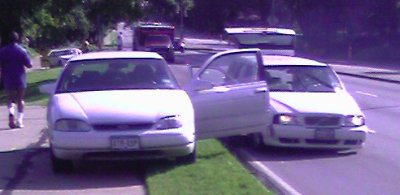This morning, while driving on southbound Garland Road (TX 78) by White Rock Lake, I saw a careening, white Nissan Maxima headed the wrong way, barrelling down at me.
I could tell it was imminently going to swipe the Volvo wagon in front of me and was barrelling right at me from my left. So I jumped a curb and slammed on my brakes.
I ended up halfway on grass and halfway on a hike and bike trail:
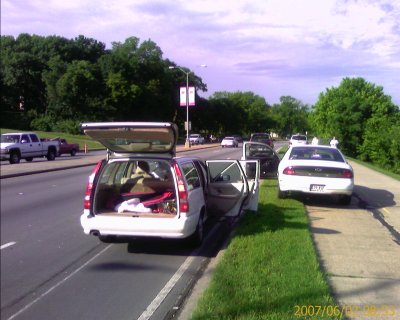
(All pictures are from my cell phone and have poor color balance.)
Luckily, no runners were in my path! I took longer than the Volvo to stop because the grass was wet with dew. Thank God for antilock braking!
If you look closely, you’ll see a Toyota Highlander about 100 feet in front of me. It also had to jump the curb. I guess the lady in the Volvo wasn’t paying good attention; she could have avoided the crash if she got off the road, although I may have then run into her?
Here’s where I launched off the curb:
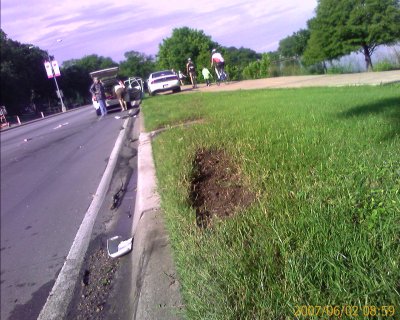
One of my left wheels did that.
I barely missed the careening Maxima.
Once I realized I was OK, I jumped out of my car and checked on the lady in the Volvo. She was dazed and just wanted out of her car. She couldn’t open her driver’s door:
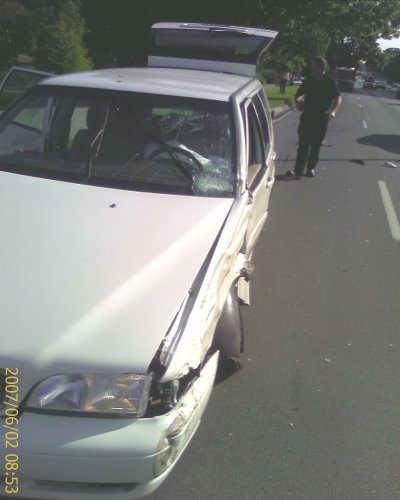
Seeing that no immediate action was needed, I called 911. I had to ask her twice to shut off her engine as I was on the phone; she was too startled to remember to do that.
Fortunately, she was totally unharmed. Her dogs were also startled and unharmed:

The Maxima’s driver appeared to be in more trouble. As soon as I was comfortable that the Volvo lady was OK, I asked a bystander to help her with her dogs so she could get out. I then went to the Maxima.
The Maxima ended up doing a 180:
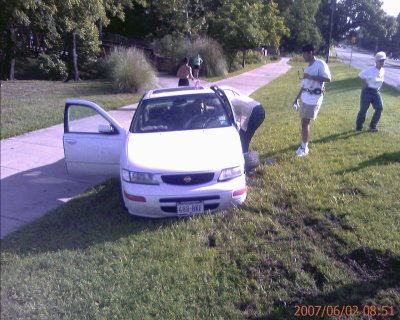
Plenty of people were attending to the guy by the time I got to him. At first, I thought his head was bleeding, but it turns out the guy’s rasta-style dreadlocks were hanging over his shoulder. He was shaking and in apparent mild shock. Bystanders were reassuring him. Since he looked OK, I didn’t interfere. His passenger compartment was intact:

He was complaining of foot pain. That wasn’t surprising given the impact location:
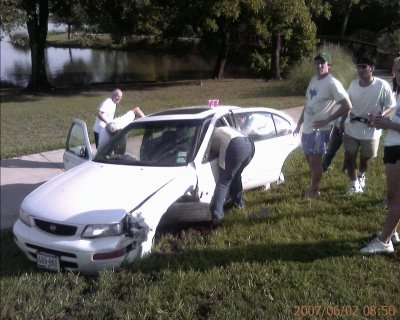
Anyone need a coil spring?
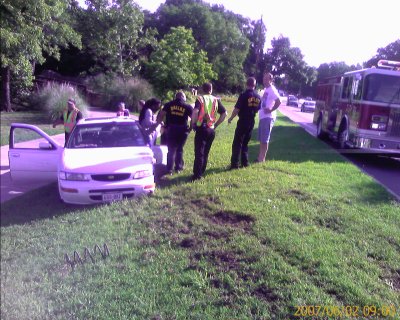
(It’s right in front of the car.)
I asked the guy in the green cap to wait for the ambulance and flag it down.
Based on the timestamps in the picture, I guess the fire truck didn’t arrive until about 5-6 minutes after the crash, and the ambulance was about 1 minute later. This surprised me since the fire station is just a mile away, up the same road. But maybe that’s normal response time?
The paramedics got the guy on his feet, so I guess he was OK?

The only cop to show up was a traffic cop (in Dallas PD, they wear red epaulets), and he arrived roughly 10-12 minutes after the crash. That response time shocked the heck out of me.
The crash appeared to be caused by an unobservant motorist who had to make a last minute lane change to avoid a slow-moving or stopped truck. The unobservant driver swerved into the Maxima’s path. In avoiding the unobservant driver, the Maxima’s driver lost control and careened into oncoming traffic.
Since I didn’t witness this part, the cop didn’t need me to stick around. After making sure the Volvo lady didn’t need more help (the emergency personnel weren’t helping her as she was unhurt), I took off for my meeting, which was about creating a foundation for White Rock Lake Park. Incidentally, my car ended up in this very park!
Do Volvos automatically blink headlights when the airbag goes off? I am not sure that a driver could make headlights blink:
